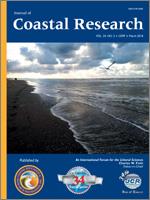Zhang, T.; Tang, S., and Zhan, H., 2018. Using satellite sensors and in situ observations to monitor phytoplankton blooms in the Pearl River Estuary.
Eutrophication in the Pearl River Estuary (PRE) has become severe with the rapid urbanization of the Pearl River Delta in recent years. As a result, large-scale phytoplankton blooms occur frequently because of eutrophication. This study investigated a massive Cochlodinium geminatum bloom near the mouth of the Pearl River in August 2011 based on data from both in situ measurements and satellites. Both methods provided a useful approach for monitoring phytoplankton blooms. The in situ measurements illustrated a high concentration of algal cells (1.5 × 107 cells L−1) in the study area, and the bloom reached dimensions of approximately 10 to 15 km in length, 8 to 10 km in width, and 100 km2 in area based on continuous field measurements. A chlorophyll algorithm for satellite sensors was developed based on in situ chlorophyll concentrations and remote sensing reflectance data collected during six cruises from August 2009 to July 2010. The algorithm was applied to Medium Resolution Imaging Spectrometer full-resolution data at the daily scale (300 m at nadir) and obtained details regarding the spatial distribution and temporal variations of the phytoplankton bloom that were consistent with the in situ measurements. An abrupt shift in wind direction and an extreme drought increased the residence time of nutrients and led to the phytoplankton bloom.





